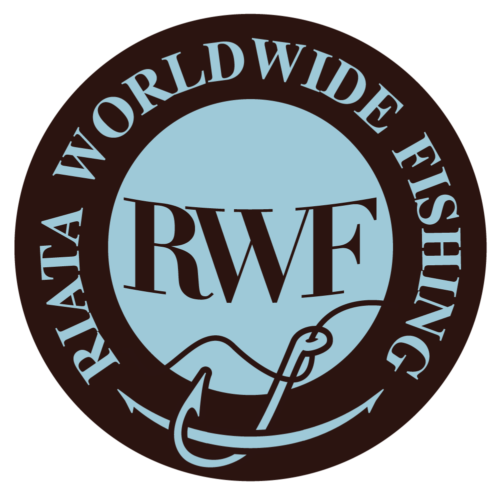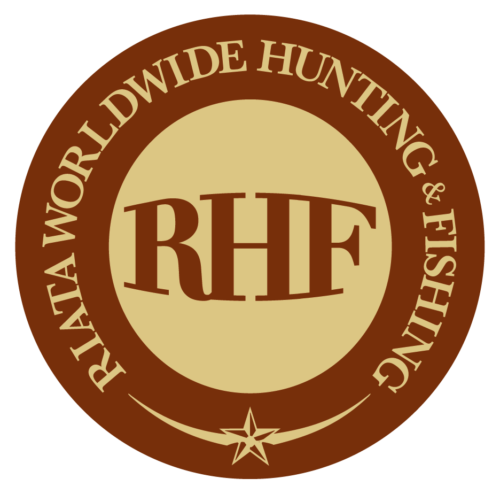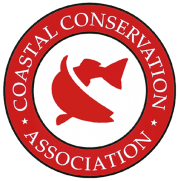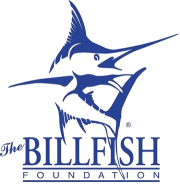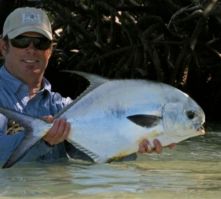
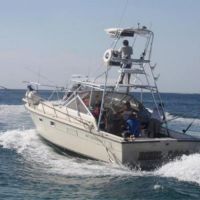
The lodge opened its doors in January 1996 and has quickly become one of the Yucatan’s most popular fishing destinations and with good reason. The lodge is located 90 miles south of Cancun in the 1.3 million acres Sian Ka’an (Mayan for “where the sky is born”) Biosphere Reserve.
Situated on a long, narrow strip of barrier beach, the lodge is virtually surrounded by water. To the east lies the blue Caribbean and a few hundred yards offshore, the Palancar Barrier Reef which stretches from southern Belize to the north of Cancun. On the western side lies the vast “El Rio” system of flats, channels, and mangrove. 10 miles to the north is the famed inlet through the barrier beach known locally as the “Boca”. And 4 miles to the south lies the incomparable Ascension Bay.
The entire area boasts some of the Caribbean’s greatest flats fishing for bonefish, permit, snook and tarpon as well as other species and reef and offshore fishing (in season). If you prefer the deep sea, our waters teem with marlin, sailfish, shark, dorado, tuna, wahoo, and all sorts of bottom species.
We offer deep sea and flats fishing. We have a full-time professional staff, clean modern boats, and some of the best fishing in the world! No long boat rides as our deep water fishing start right off the coast!
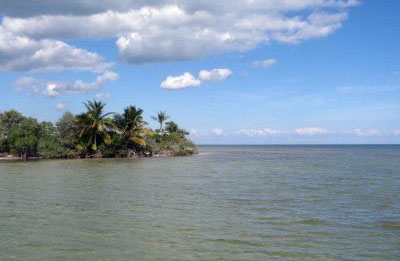
Our flats begin right in front of the lodge. Our crystal clear waters teem with bonefish, tarpon, ladyfish, permit, snook, and barracuda.
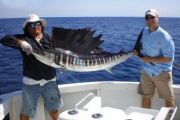
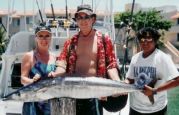
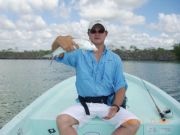
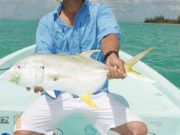
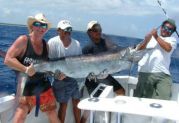
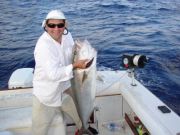
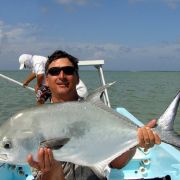
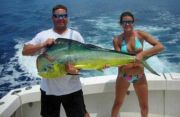
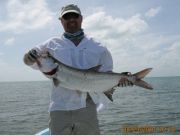
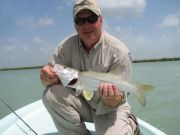
STAFF

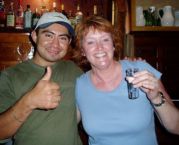
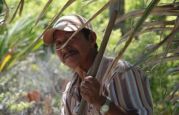

THE GUIDES
“The most experienced and professional guides in the maya area”
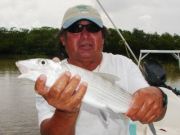
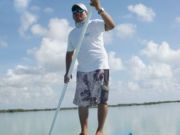
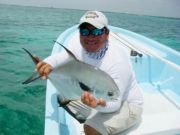
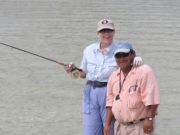
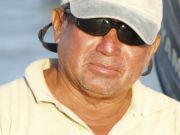
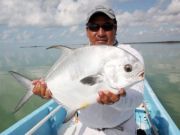
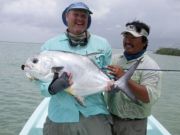
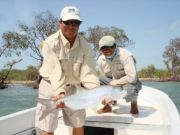
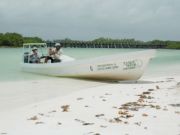
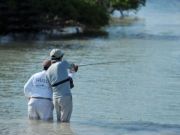
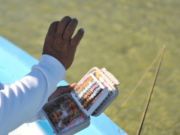
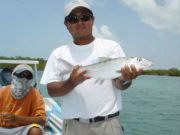
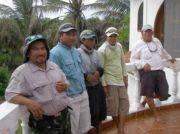
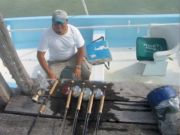
ACCOMMODATIONS
We can take up to 22 anglers in the lodge, sharing rooms. We have single and double rooms. We offer our own Fly-Shop, 12 boats with the best guides in the area, and a beautiful beach where you can relax while not fishing.
There are 11 rooms in 3 buildings, all with A/C and a private bathroom with walk-in showers, most with ocean view.
Our lodge is located in a solitary white sand beach, turquoise water, and a magnificent coral reef at 90 yards from the beach.
The spacious main lodge is the center of our activities: exquisite meals and cold drinks are being served; fly tying and fishing stories take place. Serious fishing, beautiful spots, nice and comfortable accommodations, good food and personal attention is our mission.
SEACLUSION HOUSE




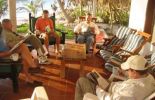
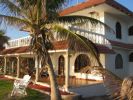
ROBINSON HOUSE
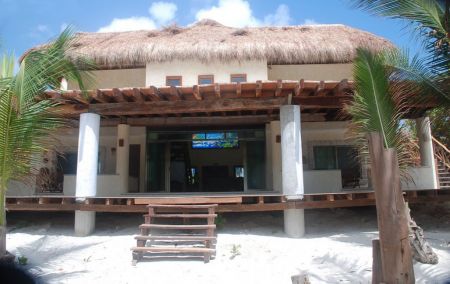






GRAND SLAM HOUSE
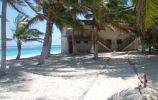

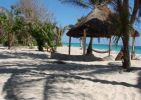


MEALS & DRINKS


Our meals are home-style, with a breakfast buffet and box lunch for our fishermen. For non-fishermen, our Chef will prepare a traditional Mexican Lunch at the lodge. The daily changing dinner menu, barbecues, and other specials.
| Breakfast | Box Lunch | Dinner | Beverages & Drinks |
| Fruit of the season like melon, watermelon, papaya, pineapple, etc. Juices: orange, pineapple, apple, etc. Eggs at your choice or pancakes. | 2 sandwiches per person plus a variety of snacks. Snacks include fresh Seafood Ceviche! | Every night includes a 3-course dinner. We offer a variety of soups, salads, and vegetables, for the main course there is fish, steak, shrimps, fresh lobster (seasonal) and chicken alternate throughout. | We include purified water, sodas, beer, wine on the table and national cocktails like margaritas, screwdrivers, vodka tonic, rum & coke, etc. We do not have imported liquors available, if you have one of your preferences, you can bring the bottle along at no extra charge. |
Personal attention is our special touch in making your trip a memorable experience. If you need to follow a special diet like low fat, low cholesterol, no sugar, no seafood, etc. please let us know – we will take care of it.
ACTIVITIES FOR NON ANGLERS
Snorkel from the beach, relax in a hammock with a cold drink, enjoy our spa treatments or venture out to explore the beauty of the Sian Ka’an biosphere. Enjoy eco tours to the Muyil Ruins or take stunning pictures on a real wild dolphin encounter.
FULL-SERVICE FLY SHOP
- Lures, flies, jigs, …
- Sunscreen
- Mosquito-repellent
- Hats and Shirts … and much more at our Pesca Maya Fly Shop.
AVAILABLE ALSO:
- Snorkel equipment for rent US$ 10.00 / day
- Fly Rods & reels US$ 25.00 / day
- Spinning Tackle US$ 15.00 / day
COMMUNICATIONS
We have a cell-phone at Pesca Maya, it works fine, but it’s expensive. Cost per minute is US$5.00, faxes can be delivered from the office in Cancun on Tuesday and Friday. For urgencies, you can use our laptop to check your emails @ US$ 10.00 per hour. We have WIFI connection if you want to bring your laptop.
CALL FOR RATES
DISCOUNTS ON LODGE PACKAGES
(DO NOT APPLY TO ONE DAY TRIPS)
Summer discount June 15 – October 31 = 20%
Fall Discount Nov 1 – February 28 = 10%
(except Christmas season Dec 18 – Jan 4)
| RATES INCLUDE: transportation as specified in each packageMeals, beverages, beers, wine on the table, liquor and cocktails, Accommodations with A/C, Private boat and guide. | NOT INCLUDED: AIRFARE, laundry, phonecalls, fishing tackle, GRATUITIES FOR STAFF |
Tips are at the client’s discretion, however, we suggest US$ 50.00 – US$ 80.00 per boat / per day and US$ 20.00 per person / per day for lodge staff, shuttle driver US $5.00 – 10.00 per day.
FISHING LICENCE
It is now mandatory in Mexico, price is 118.00 Mexican Pesos per person / per day or 256.00 Mexican Pesos per person / per week, they are not included in the rate and will have to be paid in cash at the Lodge.
DEPOSITS
A 50% deposit of the total package price per angler is due upon booking of the trip to secure your reservation. The full payment of a booking is due 60 days before arrival date.
CANCELATION POLICY
No refunds apply.
NOTE: The day trip shuttle departs Cancun at 05:00 am / Playa del Carmen at 06:00 am and leaves the lodge at 04:30 pm
GETTING THERE
You will need to fly to Cancun, Mexico, and plan on arrival between 11:00 am and 2:00 PM Cancun time. Cancun is serviced by numerous domestic carriers including American Airlines, Continental, and US Air. Direct flights are available from Miami, Dallas, Houston, Newark, Denver, LA, and several other cities. Connections from most US cities permit arrivals before 2:00 PM. If you need to do reservations or check availability these are some sites that work fine.
CUSTOMS & IMMIGRATION
Upon arrival in Cancun, you will first clear Mexican Immigration where you will present your passport and have your Tourist Card stamped (which is provided by your international carrier). You must then fill out Mexican Customs Declaration Form (available at counters in the terminal), which you will need to present before departing terminal. Next, you will claim your luggage and clear Mexican Customs. As you leave customs to proceed to the arrival lobby.
TRANSFER TO THE LODGE
As you exit the customs area to the arrival lobby, a Pesca Maya representative will meet you, who will provide the transfer to the Lodge. The drive to the Lodge will take about 3 to 3 ½ hours. Due to the duration of the transfer, Pesca Maya schedules one transfer per day, usually departing Cancun around 1:30 PM. If you arrive early (11:00 am for example), you may have to wait for other guests to arrive before leaving the airport. If there are other arrivals later that day you will depart Cancun immediately. However, guests arriving in Cancun after 3:00 PM, may be charged a special transfer surcharge. If the normally scheduled Pesca Maya transfer has already departed for the Lodge. If there are no other arrivals on your arrival day, Pesca Maya will schedule the transfer to your arrival time. The current special transfer surcharge is US$200.00 per vehicle trip, divided by the number of late arriving guests.
If you arrive in Cancun very late or your flight will leave very early on your departure date, we can assist you to find accommodations to overnight in Cancun.
Upon arrival at the Lodge, you will be greeted by resident manager Jesus Castillo, who will assist you with luggage and show your cabaña. You will have time to unpack, settle in, and take a swim or even fish from the beach before dinner at 7:00 PM
Upon confirmation of your booking, we will send you our complete PRE TRAVEL INFORMATION PACKAGE including recommendations on gear to bring.
RIVIERA MAYA GAMEFISH DESCRIPTIONS
In this section, we cover saltwater fish found off Mayan Riviera and the rich blue water offshore fishing grounds of the Mexican Caribbean. It is an uncomplicated saltwater species guide to help you identify and locate your target fish, advise you on successful fishing methods and their fighting characteristics, and the proper tackle and baits used to catch them. Pesca Maya Fishing Lodge provides you with everything you need for an exciting day of saltwater fishing. Our knowledgeable fishing guides have the experience to offer you an unforgettable day and provide the skills and techniques needed for a successful and enjoyable fishing trip.
DORADO (CORYPHAENA HIPPURUS)
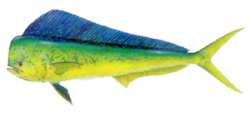
- Other Names: Dolphin, Mahi Mahi
- Range: Mexican Coastal Waters, Carribbean
- Habitat: Dolphin reams the open sea in a continuous hunt for food. Anglers seek them along rafted weed lines and around any sort of large floating object. The location of schools may also be given away by feeding birds, particularly frigate birds.
- Description: A blaze of blue and yellow or deep green and yellow when in the water, sometimes shows dark vertical stripes as well when excited. Small dark spots on the sides. Dorsal fin extends nearly from head to tail. Head is very blunt in males (bulls); rounded in females (cows). The Pompano Dolphin, Coryphaena equisetis, is often mistaken as a female or juvenile male Dolphin. It is found in most of the same waters, grows to about 5 pounds, and can be distinguished by the rounded shape of the underbelly.
- Size: Schooling fish run in similar sizes, from around a pound to nearly 20 pounds at times; larger fish are loners or can be found in pairs, bull, and cow. Big bulls often reach 50 pounds in weight and can exceed 80 pounds on rare occasions. Large cows generally top out at 40 pounds or so. The world record is 87 pounds.
- Food Value: None better.
- Game Qualities: Top of the heap in any weight class speedy. Speedy, strong and acrobatic.
- Tackle & Baits: With the Dorados anything goes. Private boat anglers seek to find a school by trolling or by running and searching for visual signs. Once a school is located it can usually be kept around the boat by restrained chumming with cut bait, and/or by keeping at least one hooked fish in the water at all times. A hot school will eagerly accept jigs and all sorts of casting baits, including flies and popping bugs. If strikes slow down, cut bait often does the trick. Big or wise fish may insist on live bait. Countless Dolphin is also caught, both by design and accidentally, on the entire gamut of rigged trolling baits and artificial trolling lures.
- Fishing Systems: Casting, Drifting, Trolling
WAHOO (ACANTHOCYBIUM SOLADRI)

- Other Names: Peto, Ono
- Range: Mexican Coastal Waters, Caribbean
- Habitat: Roams the deep blue water, but anglers can find them by working dropoffs, seamounts, weedlines and other favorable feeding locations.
- Description: Long, slender body marked with zebra-like stripes of white and deep blue or black. The mouth is elongated and narrow, and equipped with razor-sharp teeth – careful!
- Size: Common at 10-50 pounds; often grows to 80 or 90 pounds; maximum potential about 150 pounds. The world record is 158 pounds, 8 ounces.
- Food Value: White meat is tasty but rather dry. A good smoking fish.
- Game Qualities: May strike a surface bait in spectacular, greyhounding fashion, but seldom jumps after being hooked. The wild fight is characterized by several sizzling runs, usually at or near the surface. One of the fastest of all gamefish.
- Tackle & Baits: Many Wahoo are hooked on heavy tackle, incidentally in Billfishing. Best choices, however, are light to medium ocean trolling outfits with lines up to the 30-pound test; 50-pound isn’t too heavy for good sport with big specimens. A few have been caught by deep jigging or ocean casting with spinning and baitcasting tackle – even fly tackle on rare occasions. Most productive bait is a weighted feather or similar trolling lure, rigged in combination with a whole small baitfish or large strip. Surface trolling is sometimes effective, but deep trolling is much more likely to produce a Wahoo.
- Fishing Systems: Drifting, Trolling
YELLOWFIN TUNA (THUNNUS ALBACRES)
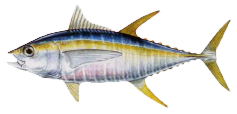
- Other Names: Allison Tuna, Ahi
- Range: Mexican Coastal Waters, Eastern Pacific, Caribbean
- Habitat: The open seas, but frequently near drop offs.
- Description: Distinguishing the Yellowfin Tuna from the Blackfin or Bigeye is sometimes difficult as many visual features are similar. Finlets of the Yellowfin are yellow, trimmed in black. Gold stripe along the side. Light underside usually shows spots and/or wavy lines. The second dorsal and anal fins of very large individuals are elongated and lunate – a feature not found on any other Tuna.
- Size: May run anywhere from a few pounds to more than 200 pounds. Maximum upwards of 380 pounds. The world record is 388 pounds, 12 ounces; Caribbean record 230 pounds.
- Food Value: One of the best.
- Game Qualities: Second only to Bluefin Tuna, and only because of smaller size.
- Tackle & Baits: Heavy outfits are indicated – 50 or 80 pounds. Light and medium ocean outfits are often used. Most are probably caught trolling with offshore trolling lures or rigged baits, but in certain areas, the best approach is to anchor on a reef near deep blue water and bring in the fish by chumming with Pilchards or similar small baitfish. In that situation, they can also be hooked by casting artificial lures with spinning, baitcasting and fly tackle – and landed, if the size is right and luck is with the angler.
- Fishing Systems: Drifting, Still Fishing, Trollin.
SIERRA (SCOMBEROMORUS MACULATUS)

- Other Names: Spanish Mackerel
- Range: Mexican Deep Waters, Eastern Pacific, Caribbean
- Habitat: Largely coastal, but roams offshore at times.
- Description: Dark above with silvery sides. Many spots, which are both yellow and brown. The body is proportionately deeper than with juvenile King Mackerel and the yellow spots appear rounder and brighter, but if in doubt, the only true identifier is the lateral line, which tapers rather gently from front to back with no severe dip.
- Size: Common at 1-3 pounds; not too unusual at 5-7 pounds; maximum potential over 10 pounds. World record 13 pounds.
- Food Value: If you like rich, rather dark fillets, they are great broiled or skinned and fried. Good smoked, too.
- Game Qualities: Outstanding on light tackle, very fast runs.
- Tackle & Baits: Spinning, baitcasting and fly outfits. Spinning is often best because the faster retrieve of a spinning reel is sometimes needed to move a lure at a pace that will interest the Mackerel. Best lures are small white nylon jigs and silver spoons, but many others work, including topwater at times. Flies should be small with lots of flashes. Best bait is small silvery baitfish, live shrimp and drifted strips.
- Fishing Systems: Drifting. Still Fishing. Trolling.
SNAPPER (LUTJANUS BUCCANELLA)
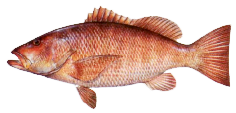
- Other Names: Blackspot Snapper, Bahamas Red Snapper
- Range: Mexican Pacific Ocean, Sea of Cortez, Caribbean
- Habitat: Nearly all are caught along outside dropoffs at depths of 200 feet or greater. Roams the deep blue water, but anglers can find them by working dropoffs, seamounts, weedlines and other favorable feeding locations.
- Description: Vivid red overall, with black crescent-shaped mark at the base of the pectoral fin.
- Size: Averages 3 or 4 pounds; the usual maximum is 10 or so. World record 7 pounds, 3 ounces.
- Food Value: Excellent
- Game Qualities: Strong fighter like other Snappers
- Tackle & Baits: Blackfin Snapper generally stays well beyond the depths of anchoring. Most are caught while drifting and jigging off cliffs and ledges. Blackfin eagerly strikes a heavy bucktail or nylon jig.
- Fishing Systems: Drifting, Trolling
AMBERJACK (SERIOLA DUMERILI)

- Other Names: Amberfish, AJ, Coronado, Cavilia, Kingfish
- Range: Mexican Coastal Waters, Eastern Pacific, Caribbean
- Habitat: Adults are common at various depths, ranging from reefs several hundred feet deep to fairly shallow wrecks and reefs. Big ones also come close to shore at times, particularly in the Keys and the Islands. Artificial reefs and wrecks all along the Gulf Coast often harbor huge schools of smaller Amberjack, and many Gulf wrecks are home to big ones as well.
- Description: Overall brownish or goldish. Heavy body. No scutes forward of tail fin. Dark oblique line through the eye that ends at the dorsal fin.
- Size: Schools of young fish are common at 5-20 pounds. Average size over deep wrecks and reefs is 30-60 pounds, but 100 pounders are not too rare and the potential maximum exceeds 150 pounds. World record 155 pounds, 10 ounces; Florida record 142 pounds.
- Food Value: Excellent smoked or fresh.
- Game Qualities: A strong, punishing fighter that powers deep and defies lifting. Fairly long runs can also occur early in the fight. A great deal of stamina matches their strength. Novices may fight Amberjack of average size for an hour or longer.
- Tackle & Baits: Amberjack are most often caught aboard charterboats and partyboats, on heavy rods and reels with lines testing 50 pounds or more, and are no patsies even then. Experienced light-tackle anglers can successfully battle them with spinning and baitcasting rigs, and even fly rods. Around wrecks, they frequently follow hooked fish to boatside, and also may rise to the top voluntarily, rhen they can be cast to with surface plugs, spoons, jigs, or big flyrod streamers and poppers. Live chum will also draw Amberjack from the depths. Best bait with heavy tackle is any sort of live fish, the friskier the better.
- Fishing Systems: Casting, Drifting, Trolling
GROUPER (MYCTEROPERCA BONACI)
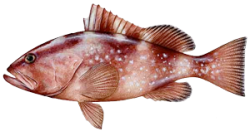
- Other Names: Bonaci, Arara, Aguaji, Mero
- Range: Mexican Coastal Waters, Pacific Coast, Deep Waters, Caribbean.
- Habitat: Groupers of many sizes and varieties are commonly found around the edges of coral reefs and rocks, from about 30 feet of water out to the deepest dropoffs. Even big fish, however, may roam to much shallower patch reefs, especially in cooler seasons. Small Blacks may also frequent creeks in some areas.
- Description: Overall color is dark gray. Markings are blacker than those of the Gag, and form box-like patterns. Fins are black, their edges also black or deep blue.
- Size: The largest of our Mycteroperca groupers, the Black, frequently exceeds 50 pounds in weight and can top 100. World record 114 pounds.
- Food Value: Excellent.
- Game Qualities: Nice fighter – Black Groupers are considered the best of the family.
- Tackle & Baits: For all-around work, ocean gear with lines of 30-pound test or higher gets the call. Light tackle fishermen in Banderas Bay, however, have caught many Blacks over 50 pounds. One key, besides a huge helping of luck, is to hook the fish while drifting instead of at anchor. The drift of the boat adds to the power of the tackle and just might help drag the big fish far enough away from his rocky “hole” that he cannot get back. For drifting or still fishing, the best baits are frisky live fish such as Blue Runners or other small jacks. Pinfish and Pilchards are good too, as are Mullet heads and other large cut baits. Best casting lures are leadhead jigs, weighing from 1-4 ounces, depending on depth. Trolling over the reefs with rigged, swimming Mullet, feather-and-strip combos, and large plugs also takes many.
- Fishing Systems: Drifting, Still Fishing, Trolling
CREVALLE JACK (CARANX HIPPOS)
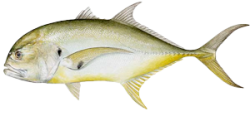
- Other Names: Jack Crevalle, Crevally
- Range: Mexican Coastal Waters, Eastern Pacific, Caribbean
Habitat: The Crevalle may show up at any time in virtually all Mexican waters, from the deep reefs to well up coastal rivers. Usually runs in schools and the smaller the individual fish, the larger the school. The biggest Jacks often cruise in pairs and are usually found in or near major inlets and around offshore wrecks and reefs of both coasts, but may come into deep bays and canals where they chase Mullet and often herd the prey against seawalls. Banderas Bay has a large population of this species. - Description: Deep, compressed body. Blunt head with black spot on rear edge of gill cover. Hard scutes forward of sickle-shaped tail. Color usually yellowish with white undersides.
- Size: Common at 1 pound or less to about 5 or 6 pounds. Plentiful up to 12 pounds in most areas. Sometimes tops 20 pounds and can reach 50 pounds or even more. World record is 57 pounds.
- Food Value: Poor by most tastes. Most of the meat is dark red and of strong flavor.
- Game Qualities: Few fish can out-pull a Crevalle of equal size. The fight is unspectacular but dogged, the usual pattern being a long first run. Jacks use their flat sides to good advantage when waging a tug-o-war.
- Tackle & Baits: Most Jacks are fairly small and are caught on the full range of light tackle by anglers seeking other game. If you target larger Jacks, say 10 pounds or more, sturdy spinning, baitcasting and fly tackle should be used, with lines no less than 8-pound test. Small Jacks, such as those frequently encountered on shallow flats, will gulp down almost any sort of natural bait, live or dead, as well as all the popular casting and flyrod lures. Big Crevalles, however, generally like their meals moving very fast. To assure hookups, you have to use fresh and frisky live fish, or retrieve your artificial lures rapidly, noisily, or both. Topwater plugs are good, as are fast-whipped jigs. Fly rodders often have to work very hard, stripping their streamers or poppers as fast as their elbows will move.
- Fishing Systems: Casting, Drifting, Still Fishing, Trolling
SAILFISH (ISTIOPHORUS PLATYPTERUS)
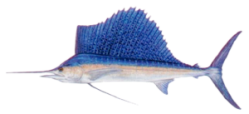
- Other Names: Atlantic Sailfish, Spindlebeak, Pez Vela
- Range: Mexican Coastal Waters, Eastern Pacific, Caribbean
- Habitat: Like the other Billfishes, the Sailfish is considered an ocean species, but generally can be found closer to land than the rest, seeming to prefer areas where coral reefs and/or freshwater runoffs mingle with ocean water.
- Description: Upper surfaces usually dark blue to black, silvery below, vertical stripes often visible on sides.
- Size: Averages 30-60 pounds, but many under 30 pounds and a few up to 100 pounds are also taken. World record 221 pounds.
- Food Value: Only kept if inadvertently killed. Protected commercially.
- Game Qualities: Unsurpassed in its size range for combined strength and spectacle.
- Tackle & Baits: Light ocean trolling or heavy spinning outfits with lines up to 30-pound test; 12 and 20 pound lines are adequate in experienced hands and provide great sport. In Southeast Florida, live-baiting, either by kite fishing or flatline drifting, has become perhaps the most popular approach to sailfishing, with Blue Runners, Goggle-eyes, Pilchards or Pinfish being the common offerings. Historically, most Sailfishing has been done with rigged trolling baits, mainly Ballyhoo and strips of Bonito or other small fish. Many Sailfish have been caught on jigs and on drifted Ballyhoo/jig combinations. Fly casters have also taken them on occasion, but Atlantic sails do not decoy as readily as their Pacific counterparts and so fly fishing for them has not become very popular, despite the fact that science has proclaimed the Sailfish of both oceans to be the same species.
- Fishing Systems: Occasionally Casting, Drifting, Trolling
BLUE MARLIN (MAKAIRA NIGRICANS)
- Other Names: Aguja Azul
- Range: Mexican Deep Waters, Eastern Pacific, Carribean
Habitat: A free-roamer that is best fished where bait is most plentiful: along weed lines; around schools of small tuna and other pelagic baitfishes; in areas where seamounts or other sub-surface structure creates up wellings and current; sharp bottom contours; temperature changes. - Description: Coloration varies a great deal. Most common phase is dark blue, almost black on the dorsal surface, shading to whitish. Usually several vertical stripes are noticeable. Early in the 20th century, these variations led anglers to believe several species were involved. Science eventually determined that the Black and Striped Marlins are strictly Pacific species, and that a Silver Marlin is non-existent. The Blue Marlin, however, is found in both hemispheres. The feature that distinguishes the Blue Marlin from others is the pointed dorsal fin that curves sharply downward. The anal fin and pectoral fins also are pointed.
- Size: From about 150 pounds to 500; not rare over 500. World record 1,402 pounds
- Food Value: Released
- Game Qualities: Best of all for speed, power and jumping ability. A real fighter.
- Tackle & Baits: While many Blues have been caught on lighter outfits, the standard is a good balanced ocean trolling outfit in the 5 pound or even 80 pound line class. Marlin baits fall into three categories: 1. Artificial trolling lures; 2. Live, fairly large baitfish, such as school Dolphin or Bonito; and 3. Rigged natural baits, such as Mullet, Mackerel, Bonito, Barracuda, extra-large Ballyhoo (“Horse Ballyhoo”). Lures are used most often because they allow more ocean to be covered. In somewhat limited areas, such as along weedlines or around seamounts and other well-established grounds, live bait is usually preferred.
- Fishing Systems: Drifting. Trolling.
WHITE MARLIN (MAKAIRA INDICUS)

- Other Names: Pacific black marlin, giant black marlin (Hawaii), white marlin (Japan and Caribbean)
- Range: Mexican Deep Water; Eastern Pacific; Caribbean
Habitat: Black marlin generally exist in the tropical and sub-tropical regions of the Pacific and Indian Oceans. They are a highly migratory, pelagic species that will rarely swim deeper than 100 feet. They are most commonly found in deep waters, near such prominent bottom structures as continental shelves and reefs. - Description: The black marlin is the only marlin with non-retractable fins. Another distinguishing trait is their dorsal fin which is proportionately the lowest of any billfish. It stands less than 50 percent of the fish’s body height. The black marlin’s back is slate blue and transitions to a silver belly. It may also have light blue stripes when excited.
- Food Value: Released
- Game Qualities: The white’s immense strength and exceptional size makes it a favored target among big-game fishermen. A fight with one of these fish can last for hours, wearing severely on the angler as well as the tackle. Anglers commonly troll brightly colored lures or rigged baitfish to catch this species. As a result of the depleted stocks, many sport fisherman are now tagging and releasing their catches.
- Tackle & Baits: While many Blacks have been caught on lighter outfits, the standard is a good balanced ocean trolling outfit in the 5-pound or even 80-pound line class. Marlin baits fall into three categories: 1. Artificial trolling lures; 2. Live, fairly large baitfish, such as school Dolphin or Bonito; and 3. Rigged natural baits, such as Mullet, Mackerel, Bonito, Barracuda, extra-large Ballyhoo (“Horse Ballyhoo”). Lures are used most often, because they allow more ocean to be covered. In somewhat limited areas, such as along weedlines or around seamounts and other well-established grounds, live bait is usually preferred.
- Fishing Systems: Sometimes Drifting. Trolling.
STRIPED MARLIN (TETRAPTURUS AUDAX)

- Other Names: Striper, Marlin, Pacific Marlin, Spikefish, Spearfish.
- Range: Mexican Deep Waters; Eastern Pacific; Carribean
- Habitat: Striped marlin occur in tropical and warm temperature waters of the Indian and Pacific Oceans. On the west coast of Mexico and the U.S. they range as far north as Oregon, but are most common south of Point Conception, California. They usually appear off Mexico in July and remain until late October.
- Description: The body of the striped marlin is elongated and compressed. The upper jaw is much extended, forming a rounded spear. The color is dark blue above, becoming silver below, with light blue bars or vertical spots on the sides.Size: World Record 339 pounds. These are smaller than the Blues and Blacks, but well worth the fight they’ll give you.
- Food Value: Released
- Game Qualities: Outstanding for speed, power and jumping ability. All Marlins are big fighters.
- Tackle & Baits: Most striped marlin are taken by trolling artificial lures in areas they are known to inhabit. Blind strikes are generally the rule, but one can occasionally tempt a “finner” or “sleeper” (marlin swimming along the surface) to strike if lures are trolled past the fish. Live bait also works well but requires more effort since the fish must usually be first spotted visually. Once a striped marlin is located, the angler should cast a bait in front of and past the fish so it can be reeled back towards the animal. Strikes usually result from properly presented live bait. Most striped marlin anglers prefer Pacific mackerel as bait.
- Fishing Systems: Drifting, Trolling.
RECOMMENDED CONVENTIONAL TACKLE
Below are suggestions for appropriate conventional tackle which will be effective in Caribbean waters all year around:
Rods: One to two 6-7′ 40-60# class trolling rods for the Dorado, Striped Marlin, and Sailfish. Roller guides are not necessary but will make fighting fish easier. A light 10-30# class spinning rod or bait caster for the smaller inshore fish such as Roosterfish, Jack Crevalle, Cabrilla, Giant Needlefish, Triggerfish, and Snapper.
Reels: A Penn 4/0 with either a lever or a star drag spooled with 30-50# monofilament for trolling. A Penn 500 or equivalent reel spooled with 20-40# monofilament for bait casting. A quality spinning reel such as a Penn 650ss spooled with 10-20# monofilament. You shouldn’t need more than 300 yards of line spooled onto any one reel. More line is better, but we often get away with about 200 yards.
Lures: Rapalas size CD11-CD14 (Magnums) and up, in green or blue mackerel. Iron spoon type lures such as Krocodiles in chrome, blue/chrome. Yo-Zuri crystal minnow lures in blue mackerel and pink/silver. Kona skirts or “Zuker” type feathers in pink/white, green/yellow, green/white, blue/white.
Terminal Tackle: We typically use Mustad 6/0-7/0 hooks rigged in tandem on 80-120# monofilament (~6″ between the hooks) as our live bait leader system. You are welcome to take along your own hooks and leader material if you wish to experiment with other systems.Live Bait: Consists of freshly caught mackerel. These mackerel are typically 8-10″ long and weigh 8 oz. to one pound each.
Rod and Reel Carrier: Rods should be transported in a hard case container. You may purchase a quality rod carrier, or make one with PVC pipe.
